The collapse of Hanjin Shipping will probably spark fresh consolidation among container lines as they attempt to ride out the shock waves buffeting the industry, the Hapag-Lloyd chief executive Rolf Jansen said.
“A lot of people hadn’t expected the difficulties for Hanjin in the magnitude we have seen them,” he said. “It will change behaviour”, with some participants now assessing whether it might not be better to “team up”, he said.
Hapag-Lloyd, Germany’s No 1 carrier, which has used mergers to bring down costs and counter the slump that has shaken shipping for the past eight years, does not plan to buy the Asian company or any of its vessels, now stranded at sea and various ports across the globe. Hapag-Lloyd is busy completing its merger with United Arab Shipping, headquartered in Dubai, which it aims to do by the end of this year. “We better make a success of that first,” Mr Jansen said.
Hanjin’s demise has disrupted global supply chains as stores in Europe and the United States stock up for the Christmas shopping season. While the gain in freight rates after the collapse may boost Hapag-Lloyd’s revenue “a bit” this month and next, that alone will not trigger a sustained recovery in the industry, Mr Jansen said.
Hapag-Lloyd shares have gained 15 per cent since Hanjin filed for court receivership on August 31, though they still trade 6.9 per cent below their November 6 initial public offering price. “We are not a big partner of Hanjin, so the effect on us is very limited and manageable,” Mr Jansen said.
A new wave of mergers may bolster the position of the biggest carriers, led by AP Moeller-Maersk’s Maersk Line, in an industry in which five of the 20 biggest carriers have disappeared in the past two years alone. Transactions included the combination of China’s two biggest liners and Hapag-Lloyd’s takeovers of Chile’s Compañía Sud Americana de Vapores in 2014 and UASC this year.
Whether or not Hanjin rivals will snatch up some of the 39 container ships owned by the South Korean company will depend on the strategy of the various vessel-sharing alliances, including Maersk’s 2M partnership with Mediterranean Shipping, Mr Jansen said. “The vessels will at some point go somewhere, but let’s not forget that many of the ships are still full” and financial obligations mean they cannot be easily acquired by other parties, he said.
Only a handful of vessels in Hanjin’s owned fleet are attractive for buyers, while several others are likely to be scrapped, Copenhagen’s SeaIntel Maritime Analysis said. About 40 per cent of the ships are in the “less attractive” smaller segments, it said. “With average ages of close to 10 years, these vessels are likely not going to be very fuel efficient,” SeaIntel said. The analysts singled out four bigger vessels with a capacity of 13,000 standard 20-foot containers as the “most interesting for a potential buyer”.
“We will look at the vessels like everyone else, but our primary objective is not to grow faster than the market,” Mr Jansen said. The UASC deal means Hapag-Lloyd has added “quite a lot of capacity” to its fleet, he said. He expects Hapag-Lloyd’s transport container volume to grow in line with the market, which will probably be 2 per cent to 3 per cent this year.
business@thenational.ae
Follow The National's Business section on Twitter

